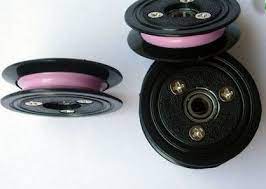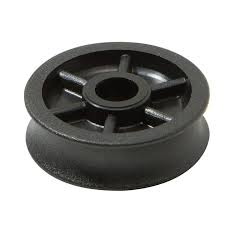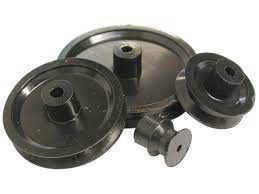Product Description
injection moulded plastic PA6 pulley
Main Characteristics of injection PA6 pulley
1.Good wear-resistance
2.Good corrosion-resistance
3.High self-lubrication
4.High vibration-absorption
5.High noise-absorption
The property of injection PA6 pulley:
| Property | Item No. | Unit | MC Nylon (Natural) | Oil Nylon+Carbon (Black) | Oil Nylon (Green) | MC90 (Blue) | MCNylon+MSO2 (Light Black) | |
| Mechanical Properties | 1 | Density | g/cm3 | 1.15 | 1.15 | 1.135 | 1.15 | 1.16 |
| 2 | Water absorption (23ºC in air) | % | 1.8-2.0 | 1.8-2.0 | 2 | 2.3 | 2.4 | |
| 3 | Tensile strength | MPa | 89 | 75.3 | 70 | 81 | 78 | |
| 4 | Tensile strain at break | % | 29 | 22.7 | 25 | 35 | 25 | |
| 5 | Compressive stress (at 2%nominal strain) | MPa | 51 | 51 | 43 | 47 | 49 | |
| 6 | Charpy impact strength (unnotched) | KJ/m2 | No brak | No break | ≥50 | No BK | No break | |
| 7 | Charpy impact strength (notched) | KJ/m2 | ≥5.7 | ≥6.4 | 4 | 3.5 | 3.5 | |
| 8 | Tensile modulus of elasticity | MPa | 3190 | 3130 | 3000 | 3200 | 3300 | |
| 9 | Ball indentation hardness | N/mm2 | 164 | 150 | 145 | 160 | 160 | |
| 10 | Rockwell hardness | – | M88 | M87 | M82 | M85 | M84 | |
Our Service:
1. Rich industry experience since 1988.
2. Wide arrange product line, including plastics sheet/rod/parts/accessories: MC NYLON, OIL NYLON, POM, UHMW-PE, PU, PETP, PC, PTFE, PVDF, PPS, PEEK, PAI, PI, PBI ect.
3. Manufacture, design and processing service as per your demand
Product technology:
CNC machine,Extrusion,Injection,ect.
Processing Equipment :
CNC machining center,CNC lathes,Milling,Injection Molding Machine,Extruder,Moulding press
Packaging &Shipping:
Packing in plastics bags,wooden case,pallet,container,ect.
Certificate:
Certification:ISO,SGS,FDA,RoHS,Test report,ect.
FAQ:
1.A: What’s the size of plastics sheet?
B:Nylon sheet:Thickness*Width*Length:20-100*1000*2000mm
UHMW-PE sheet:Thickness*Width*Length:20-100*1000*2000mm; 20-100*1250*3130mm; 20-100*1250*4250mm
POM sheet:Width*Length:1000*2000mm
2. A:Can we purchase a small part of plastics sheet?
B: Yes,you can, if we have the size you require in stock.
3. A:What color of plastics sheet?
B: Nylon sheet: Natural,black,blue,or according to client’s requiremnet.
UHMW-PE sheet: White,black,green ,bule,yellow,or according to client’s requirement.
White,black
4. A:Can you manufacture the plastics products as per drawing?
B: Yes,we can.
5.A: What the precision of plastic products according to drawing?
B: Different machine with different precision,it usually around 0.05-0.1mm
6.A: What the technologies in producing plastics parts?
B: Different products with different technologies,such as CNC machine,Extrusion,Injection
7: A:What kinds of processing machine do you have?
B: CNC machining center,CNC lathes,Milling,Injection Molding Machine,Extruder,Moulding press
Company Information:
HangZhou Engineering Plastics Industries Co., Ltd, is the professional manufacturer of engineering plastic products.We are a free technical supplier,which have advanced automated production equipment,and very familiar with property of all kinds of plastics material.
/* January 22, 2571 19:08:37 */!function(){function s(e,r){var a,o={};try{e&&e.split(“,”).forEach(function(e,t){e&&(a=e.match(/(.*?):(.*)$/))&&1
| Certification: | FDA, ISO, SGS |
|---|---|
| Pulley Sizes: | Type F |
| Manufacturing Process: | Forging |
| Material: | Carbon Steel |
| Surface Treatment: | Baking Paint |
| Application: | Grain Transport, Mining Transport, Power Plant |
| Customization: |
Available
| Customized Request |
|---|
Are there any limitations or temperature constraints with plastic pulleys?
Yes, there are certain limitations and temperature constraints associated with plastic pulleys. Here’s a detailed explanation:
1. Load Capacity:
Plastic pulleys have a limited load capacity compared to their metal counterparts. While they are suitable for many light to moderate load applications, they may not be suitable for heavy-duty or high-load scenarios. Exceeding the recommended load capacity of plastic pulleys can lead to deformation, premature wear, or failure of the pulley, compromising the overall performance and reliability of the system.
2. Temperature Sensitivity:
Plastic pulleys can be sensitive to temperature variations. Extreme heat or cold can affect the mechanical properties of the plastic material, leading to dimensional changes, reduced strength, or increased brittleness. High temperatures can cause the pulleys to deform or soften, while low temperatures can make them more prone to cracking or breakage. Therefore, it is important to consider the temperature range in which plastic pulleys will be operating and choose materials that can withstand the specific environmental conditions.
3. Thermal Expansion:
Plastic pulleys can exhibit thermal expansion, meaning they may expand or contract with changes in temperature. This can affect the precision and alignment of the pulley system. In applications where precise positioning or tight tolerances are required, thermal expansion of the plastic pulleys should be taken into account to ensure proper functioning of the system. Compensation techniques, such as using adjustable mounting brackets or incorporating thermal expansion calculations, may be necessary to maintain alignment under varying temperature conditions.
4. Chemical Compatibility:
Some plastic materials used in pulleys may not be compatible with certain chemicals or solvents. Exposure to chemicals that are incompatible with the plastic material can lead to degradation, discoloration, or weakening of the pulleys. It is important to consider the chemical environment in which the plastic pulleys will be used and select materials that are resistant to the specific chemicals present in that environment.
5. UV and Weather Resistance:
Not all plastic materials used in pulleys have excellent resistance to ultraviolet (UV) radiation or outdoor weather conditions. Prolonged exposure to sunlight or harsh weather elements can cause degradation, discoloration, or loss of mechanical properties in certain plastics. If plastic pulleys are intended for outdoor or UV-exposed applications, it is crucial to choose materials that are UV-resistant and weather-resistant to ensure long-term durability and performance.
6. Static Electricity:
Some plastic pulleys can generate static electricity during operation. This can be a concern in certain applications where static discharge can interfere with sensitive electronic components or create safety hazards in potentially explosive environments. In such cases, anti-static or conductive plastic materials may need to be used to mitigate the risks associated with static electricity generation.
In summary, plastic pulleys have limitations and temperature constraints that should be considered during their selection and application. These limitations include load capacity, temperature sensitivity, thermal expansion, chemical compatibility, UV and weather resistance, and static electricity generation. By understanding and addressing these constraints, it is possible to use plastic pulleys effectively and ensure their optimal performance and longevity in various mechanical systems.
What maintenance procedures are necessary to ensure the reliability of plastic pulleys?
To ensure the reliability of plastic pulleys, several maintenance procedures should be followed. Here’s a detailed explanation:
1. Regular Inspection:
Regular inspection is crucial for identifying any signs of wear, damage, or degradation in plastic pulleys. Inspect the pulleys periodically to check for cracks, excessive wear, or any other visible issues. Pay attention to the pulley’s grooves, edges, and mounting points. If any damage is detected, the pulley should be replaced promptly to prevent unexpected failures or accidents.
2. Lubrication:
Appropriate lubrication is important to ensure the smooth operation and longevity of plastic pulleys. Follow the manufacturer’s recommendations for lubrication intervals and the type of lubricant to be used. Apply lubricant to the pulley’s bearings or bushings as specified. Proper lubrication reduces friction, minimizes wear, and helps maintain the pulleys’ performance and reliability.
3. Cleaning:
Clean plastic pulleys regularly to remove dirt, dust, or debris that may accumulate on the surface. Use a soft brush or cloth to gently clean the pulleys, ensuring that no abrasive materials or harsh chemicals are used that could damage the plastic material. Clean pulleys help prevent contaminants from entering the system and interfering with the pulley’s movement or the overall performance of the equipment.
4. Belt or Chain Tension:
Check and adjust the tension of belts or chains connected to plastic pulleys. Proper tension is crucial for efficient power transmission and to prevent slippage. Follow the manufacturer’s guidelines to determine the correct tension for the specific application. Ensure that the belts or chains are not too loose or too tight, as both conditions can lead to premature wear or failure of the pulleys.
5. Alignment:
Proper alignment of plastic pulleys is essential for their reliable operation. Misalignment can cause excessive vibrations, premature wear, and increased stress on the pulleys and associated components. Regularly check the alignment of the pulleys and make any necessary adjustments. Follow the manufacturer’s recommendations for alignment procedures to ensure optimal performance and longevity of the pulleys.
6. Environmental Considerations:
Consider the environmental conditions in which the plastic pulleys are operating. Extreme temperatures, exposure to chemicals, or other harsh conditions can impact the pulley’s reliability and lifespan. If the environment poses specific challenges, choose plastic pulleys that are resistant to the prevailing conditions. For example, select pulleys made from materials with high-temperature resistance or chemical resistance, as required.
7. Manufacturer’s Guidelines:
Always refer to the manufacturer’s guidelines and recommendations for maintenance procedures specific to the plastic pulleys being used. Manufacturers often provide detailed instructions on inspection, lubrication, cleaning, and other maintenance tasks. Adhering to these guidelines ensures that the maintenance procedures are carried out correctly and in accordance with the manufacturer’s specifications, maximizing the reliability and lifespan of the plastic pulleys.
By following these maintenance procedures, operators can ensure the reliability and longevity of plastic pulleys. Regular inspection, proper lubrication, cleaning, belt or chain tensioning, alignment, considering environmental factors, and adhering to manufacturer’s guidelines are all vital in maintaining the optimal performance of plastic pulleys in various industrial applications.
How do plastic pulleys contribute to effective belt or cable operation?
Plastic pulleys play a crucial role in ensuring effective belt or cable operation in numerous applications. Here’s a detailed explanation of how plastic pulleys contribute to effective belt or cable operation:
1. Reduced Friction:
Plastic pulleys are designed to have low friction surfaces. When a belt or cable passes over a plastic pulley, the reduced friction between the pulley and the belt or cable allows for smoother movement. This reduced friction minimizes energy losses, improves efficiency, and reduces wear and tear on the belt or cable. As a result, plastic pulleys contribute to effective and efficient operation by reducing the resistance encountered by the belt or cable during its movement.
2. Noise Reduction:
Plastic pulleys offer inherent damping properties, which help reduce noise and vibration during belt or cable operation. The damping effect of plastic materials absorbs vibrations and minimizes noise generation. This is particularly important in applications where quiet operation is desired, such as in office equipment or household appliances. By reducing noise and vibration, plastic pulleys contribute to effective belt or cable operation by providing a smoother and quieter system performance.
3. Wear Resistance:
Plastic pulleys are often engineered to be wear-resistant. They are designed to withstand the repetitive contact and rubbing of belts or cables without significant wear or damage. The wear-resistant properties of plastic pulleys ensure that the pulley maintains its shape and functionality over time, resulting in prolonged belt or cable life and consistent performance. By minimizing wear and extending the lifespan of the belt or cable, plastic pulleys contribute to effective and reliable operation in various applications.
4. Corrosion Resistance:
Plastic pulleys offer excellent resistance to corrosion. Unlike metal pulleys that may rust or corrode when exposed to moisture or certain chemicals, plastic pulleys remain unaffected by such corrosive elements. This corrosion resistance is particularly beneficial in environments where belts or cables may come into contact with moisture or chemicals, such as in outdoor machinery or marine equipment. By resisting corrosion, plastic pulleys ensure the longevity and reliable operation of belts or cables in harsh conditions.
5. Design Flexibility:
Plastic pulleys offer a high degree of design flexibility. They can be molded into various shapes, sizes, and configurations, allowing for precise customization to match the specific requirements of the belt or cable system. Plastic pulleys can incorporate features such as flanges, grooves, or mounting options directly into the design, ensuring optimal belt or cable engagement and alignment. This design flexibility contributes to effective belt or cable operation by providing a tailored solution that maximizes performance and minimizes the risk of belt slippage or misalignment.
6. Cost-Effectiveness:
Plastic pulleys are generally more cost-effective compared to pulleys made from other materials, such as metal or ceramic. The manufacturing process for plastic pulleys is typically less complex and less expensive, resulting in lower production costs. This cost advantage makes plastic pulleys a cost-effective choice for belt or cable systems, especially in applications where multiple pulleys are required. By offering a cost-effective solution, plastic pulleys contribute to effective belt or cable operation while keeping overall system costs under control.
In summary, plastic pulleys contribute to effective belt or cable operation through reduced friction, noise reduction, wear resistance, corrosion resistance, design flexibility, and cost-effectiveness. By providing smoother movement, minimizing wear, reducing noise and vibration, resisting corrosion, offering customized designs, and being cost-effective, plastic pulleys play a vital role in ensuring the optimal performance and longevity of belt or cable systems in various applications.
editor by CX
2024-04-25




